Knowing only a dozen legendary works of the Louvre, in addition to Dzhokonda, Nicky of Samothrace and Venus of Milos, you can shine with erudition in matters of art, even as part of a tourist group, even in front of their own family.
Popular tours of the Louvre
You can walk around the Louvre on your own: there are layouts of exhibits and audio guides. But in conditions of limited time it is more profitable to go with a guide: group excursion “The main treasures of the Louvre in 2 hours” will cost € 35 per person, individual “Big walk on the Louvre” – € 165 per tour (from 1 to 6 people). Questions for guides on Tripstere can be asked absolutely for free.
- “Christ at the pillar,” Antonello da Messina.
Acquired in the Louvre collection (1475-1479).
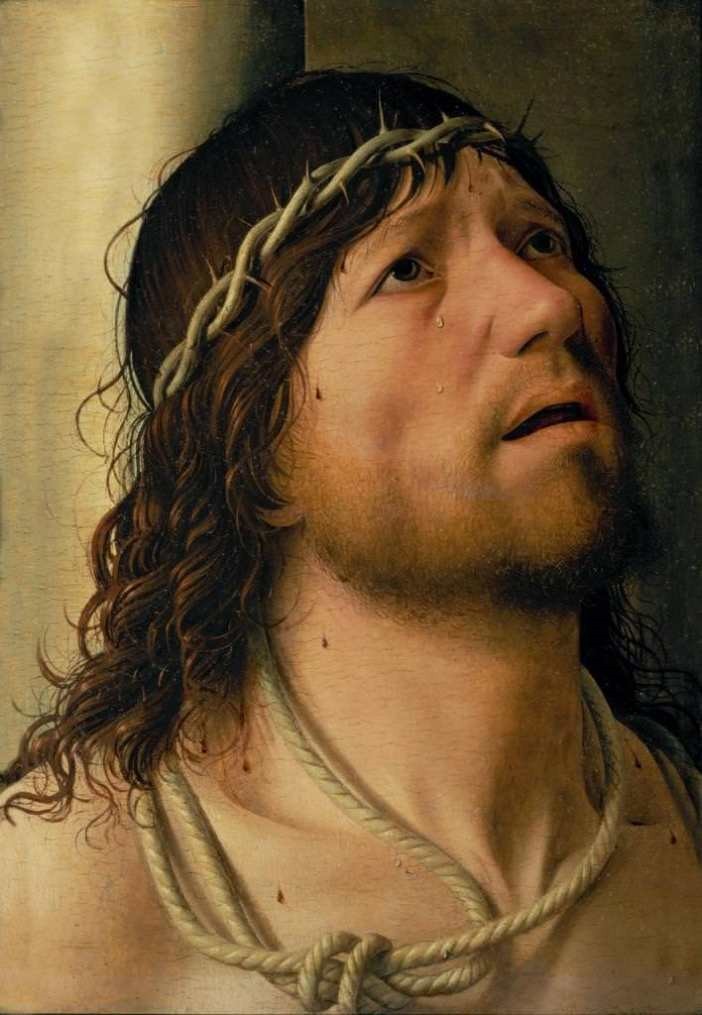
The acquisition of this painting allowed the Louvre to add to a significant collection of Italian paintings extremely exciting work, which belongs to the last period of the Sicilian artist. Antonello Messina was an innovator and undisputed authority for Renaissance painters. The small size of the masterpiece (29.8 x 21 cm) does not correspond to the monumental grandeur of the image crowned with the crown of thorns of Christ, which turned the eyes to heaven. The iconography goes back to the gospel text “Behold, man”, when after the scourging and crowning of Christ’s head with a crown of thorns it is shown to the crowd.
The viewer looks down on his backward-faced face with traces of tears and a drop of blood, a shadow from the rope and a protruding knot resting on the frame of the painting. All this creates a sense of volume and real presence, which is unbelievable for the XV century.
- “Madonna of Victory,” Andrea Mantegna. Acquired in the Louvre collection (1496).
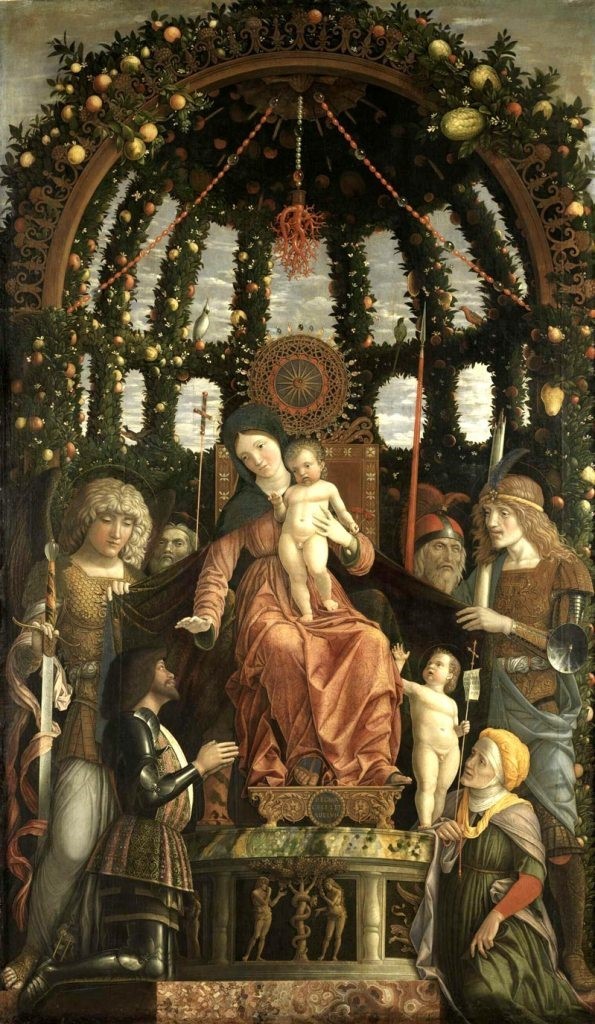
Andrea Mantegna worked for most of his time in Padua, serving Ladies and Gentlemen of Mantua, where he moved in 1461. There he found ideal conditions for the development of his crystal clear, inspired by antique painting. The reason for this painting, which has been in the Louvre since 1798, was the victory of Francesco Gonzaga (Marco Mantua and Captain of the Anti-French League) at the Battle of Fornovo near Parma. As a result, the altarpiece was vowed to the Chapel of Santa Maria Vittoria. The head of the patron saint of the city of St. Andrew can be seen on the left above the vestment of the Virgin Mary. The three saints are interceding for the Marquis.
Two of them – Archangel Michael with a sword and St. George with a broken peak – were entrusted to support the mantle of the Madonna, under which Francesco took refuge.
- “Mona Lisa,” Leonardo da Vinci.
Painting from the collection of Francis I (1503-1506).
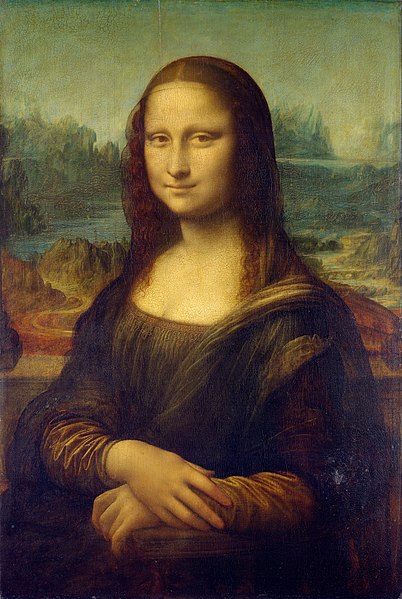
“Mona Lisa” or “Gioconda” is not only one of Leonardo’s most famous works, but also the most famous female face in the world, which stirred the imagination of scientists, writers and poets of all time. A certain opinion, who was this young woman, does not exist until now. The main version of this priceless painting by the Louvre shows Lisa Gerardini, wife of Francesco Giocondo. The dates are determined “by eye”, based on the style of the artist of the time. In one version, the model’s husband allegedly refused to pay for the painting. But experts tend to the fact that Da Vinci himself did not give the work while living in Florence, because he did not finish it.
He completed it only in Rome, commissioned by Giuliano Medici, who wanted to have at least some work master. When Giuliano died and Leonardo moved to France, the painting was found in his former workshop, and it was bought by Francis I.
- “The Beautiful Gardener”, Raphael.
Painting from the collection of Francis I (1507)
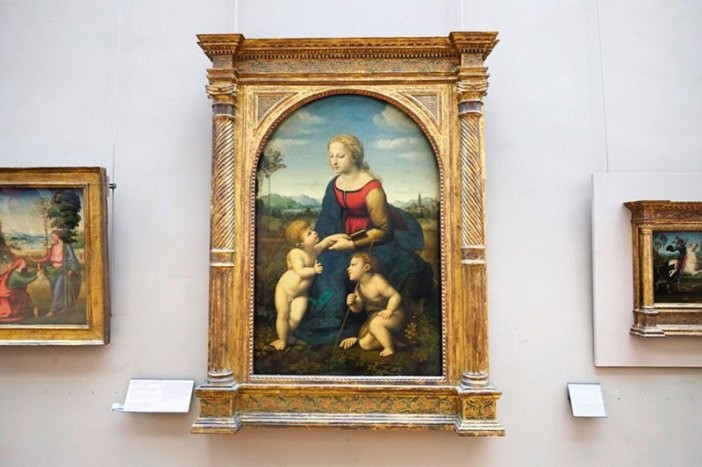
One of the most famous masterpieces of the Louvre was named “The Beautiful Gardener” thanks to the flowering beauty of a female figure in the middle of a meadow. In addition, it is one of the most famous Madonna Raphael, written in his first Florentine period (1504-1508), when a novice artist from Urbino in all his efforts to move away from the manner of his teacher Perugino and find his own style. His works were inspired by Leonardo da Vinci, Michelangelo and Fra Bartolomeo. In particular, this painting shows the influence of Leonardo (it is noticeable in the light sphumato of colored construction).
But the style of Raphael himself – the quiet charm and serenity, which later will become “branded”.
The main contribution of the artist to the Italian Renaissance is naturalness, soulfulness and incredible harmony. This painting, signed and dated by Raphael himself, became one of the models for artists until the XIX century.
- “Country Concert,” Titian.
Painting from the collection of Louis XIV (1510).
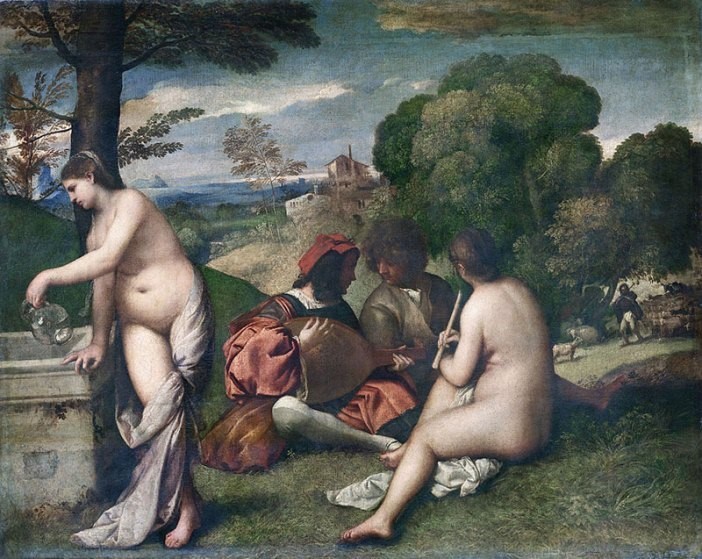
Around this painting there were long debates, the authorship was attributed to both Titian and Giorgione. Most of the specialists tend to think that it is the work of Titian, Giorgione’s disciple. What is most striking is the atmosphere of the entire scene, a nostalgic reminder of Arcadia and a reference to the Venetian Renaissance. There seems to be no dialogue or exchange of views between the characters. The whole scene seems to be intended for a narrow circle of devotees and connoisseurs. From Giorgione there is the charm of the landscape, a fusion of music, rustling crowns and grass. But Titian’s confident grasp of perspective, velvet and silk in contrast to nude nature. The “concert” itself is more of a “duet”, a lute and a flute.
- “Changed with my wife,” Quentin Massys.
Purchased in the Louvre collection (1514).
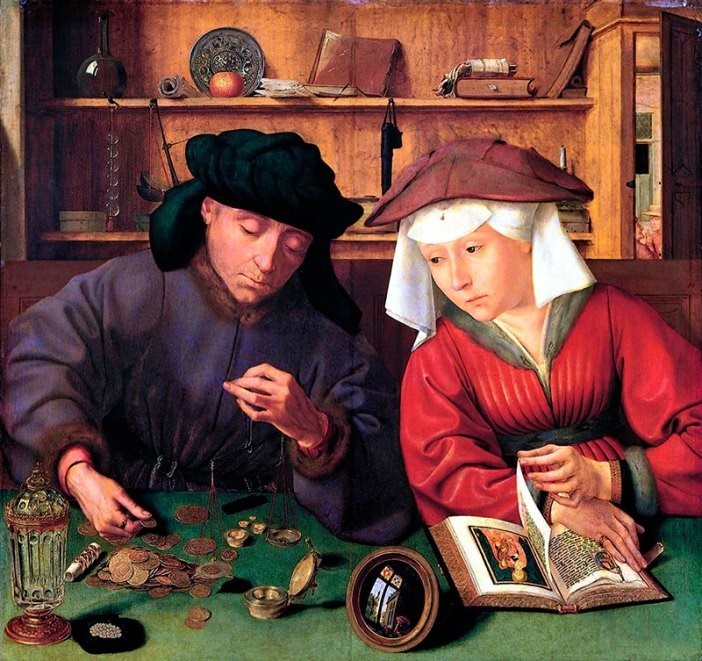
This work is dated by the artist, and in 1514. – is the beginning of a whole milestone in the history of secular painting. The vast number of repetitions of this plot is based on the lost prototype of Jan Van Eyck. The painting by Quinten Masseis depicts a married couple engaged in business. But the deep moral meaning is not hard to read. The husband looks carefully at the scale. The woman, putting her hand on the prayer book, looks at her husband with awe, aware that there is nothing divine in trade. The trader’s cunning is compared to submission to faith.
The contrast between the spiritual and material is emphasized in small details: in the convex mirror on the table (Van Eyck’s motif), a man sitting at the window frame in the form of a cross is reflected. Specialists say it is a hint of religion. At the same time, two characters in the doorway are idly chatting, “desecrating” the divine atmosphere.
- “Marriage in Cana,” Paolo Veronese.
Acquired in the Louvre collection (1562-1564).
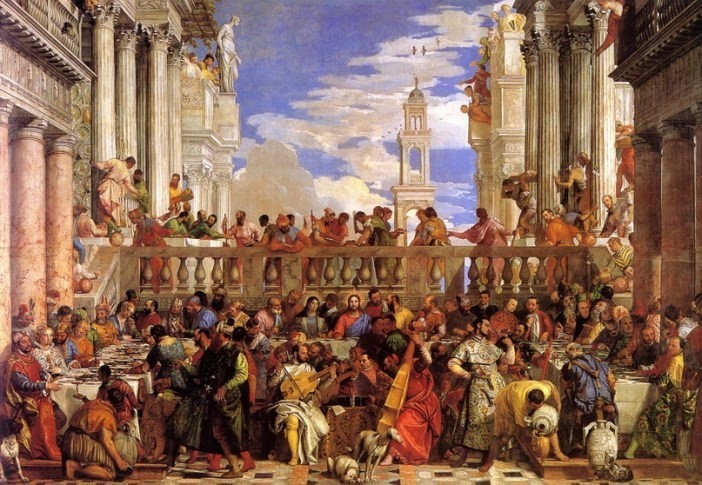
This sparkling canvas, intended for the refectory of the Benedictine Monastery of San Giorgio Maggiore in Venice, is the fruit of the scenographic imagination of Paolo Veronese, creator of decorative painting. One of the most famous masterpieces of the Louvre was restored at the beginning of the XXI century, but because of its gigantic size (660 x 990 cm) they did it right on the spot, without taking the painting out of the museum hall. As in other compositions, Veronese transformed the religious scene into a secular feast attended by a huge number of sixteenth century Veniceans.
Servants, jesters, animals, valuable utensils, embroidered stone tablecloths – all this is enclosed in light and open architectural forms against the background of Venetian buildings. Most of them are Andrea Palladio’s classic style buildings.
- St. Louis of France and His Page, El Greco.
Presented to the Louvre by the Maecenas (1586-1596).
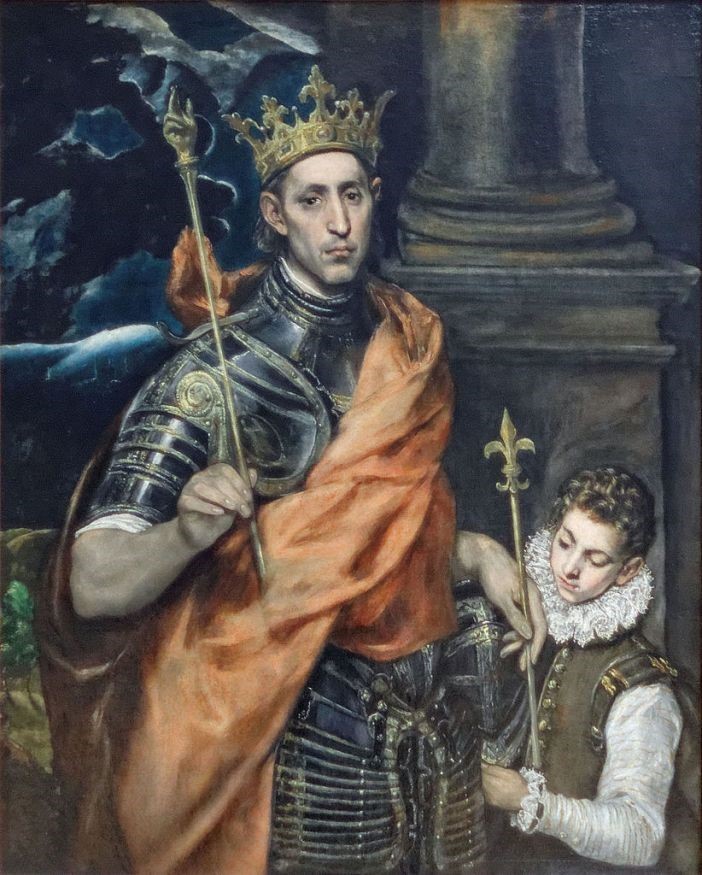
The painting belongs to the most mature period of the artist’s work (by Greek origin), when the pictorial and stylistic skills he acquired in Italy, merged in his painting with formal, late Gothic techniques, with which he met in Toledo. By this time, El Greco had reached a level in his art that is defined as an “anti-naturalist” concept. If in human language, it is “supernatural”, when the genre of portrait gives the image the deepest spiritual meaning. The natural result can never be achieved if the laws of geometry and proportions are observed.
But when it comes to kings violation of the laws of painting and perspective is justified: on a huge shoulder and extended arm El Greco transferred the center of gravity of the entire figure. The ruler is mighty and the henchman against his background is weightless and almost ethereal. It is easy to guess what impression Louis makes on the viewer.
- Arrival of Maria Medici in Marseille, Peter Powell Rubens.
Painting from the collection of Louis XIV (1622-1625).
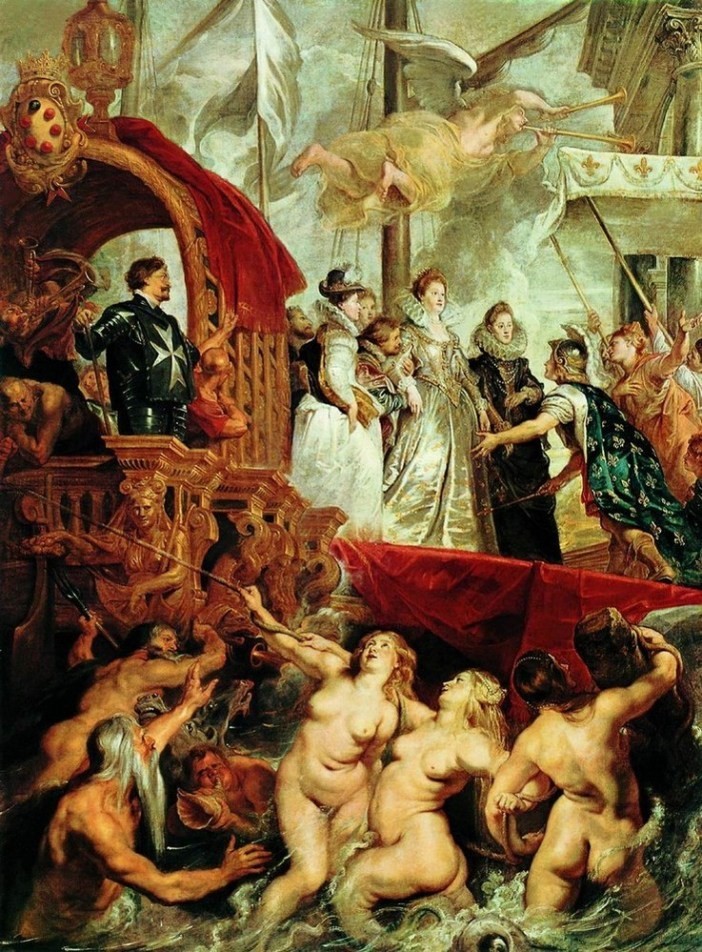
This is one of a series of paintings on historical and allegorical subjects from the life of Mary Medici (twenty one in all), commissioned by the Queen of France for the Luxembourg Palace. During the reign of Napoleon, the paintings were taken out of the palace, as the Senate moved there, and placed directly in the Louvre, where since 1900 they are equipped with an entire hall. Depicting the arrival of the young queen, Rubens clearly divided the canvas into two zones. The top, shifted to the depths, is filled with decorative details, on it stands out a group of court ladies and subjects, whose measured gestures make this part of the composition static. Below, in the foreground, is a group of sea deities. This is a feast of succulent forms that is typical of Rubens, covered in a single gust.
- “Portrait of Doña Rita de Barrenechea,” Francisco Goya.
The gift of Carlos de Beistegui (1793)
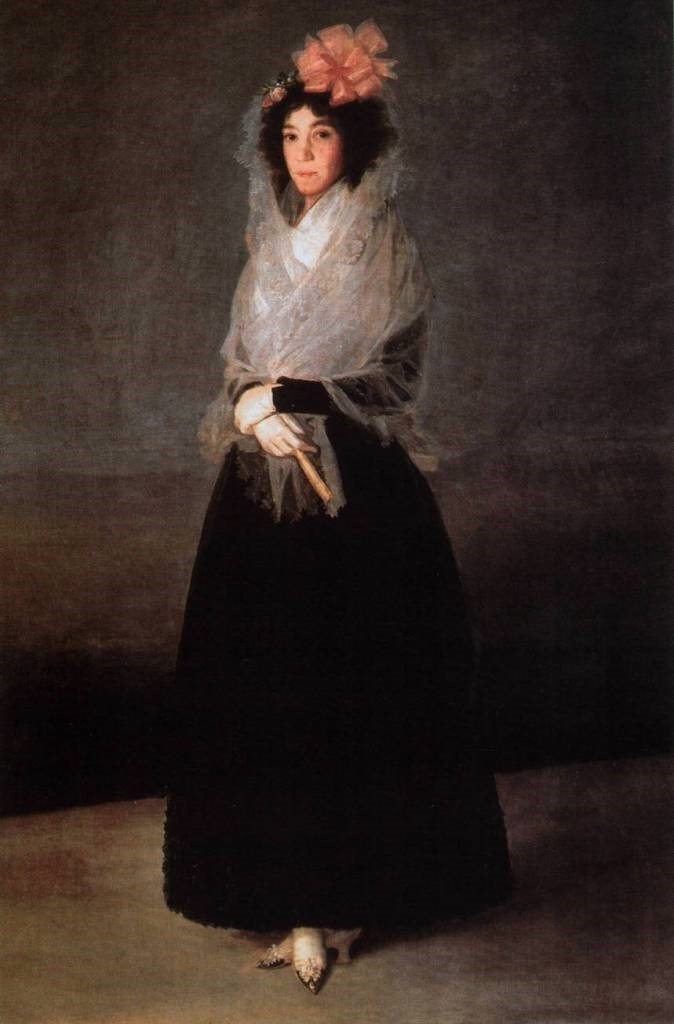
One of the few works of Goya in the collection of the Louvre was written after the illness of the artist, in consequence of which he lost his hearing. Beginning in 1780. Francisco Goya becomes a fashionable portraitist among Madrid’s aristocrats. When the artist painted this portrait, he used techniques that he had tried for a long time. But the more obvious is the hand of the Spanish master. The portrait stands in a strict dress, the only hint of luxury – a pink bow in his hair. The manner of execution – one of the most elegant in the XVIII century. The painting was painted during the artist’s creative maturity and is considered one of the best works of Goya in the quiet side of his painting.
The other side of the work – the image of inhuman suffering, cruelty, misery and injustice of the world – until we leave the picture behind.
- “Jellyfish Raft,” Theodore Gericault.
Acquired in the Louvre collection (1819).
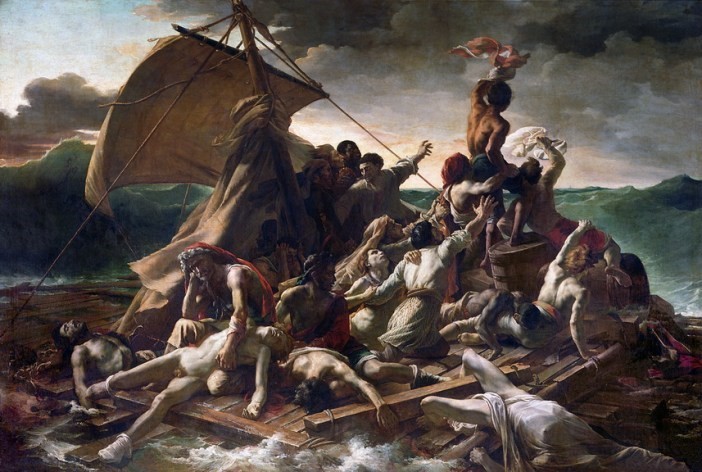
In 1816. 25-year-old Theodore Gericault was in Italy, where he met with antiquity and the great art of the XVI century. According to the legendary “Raft “Jellyfish”, the emergence of his style, can be seen how influenced the young artist the best works of Michelangelo and Caravaggio (some of them can also be seen in the Louvre). Exhibited at the 1819 Salon, this acclaimed masterpiece of the Louvre caused much resentment due to its gloomy realism. Gericault was shaken by the shipwreck of the frigate “Medusa” and the drama of 149 people. They fought for 12 days for life away from the Congolese coast. The painting depicts the culmination of 15 surviving mariners who saw a ship that could have saved them far away.
Despite the complexity of the movements of the figures, the extraordinary tension of the senses, and the angularity of the bodies, the composition was very consistent
- “Freedom, leading the people,” Eugène Delacroix.
Acquired in the Louvre collection (1830).
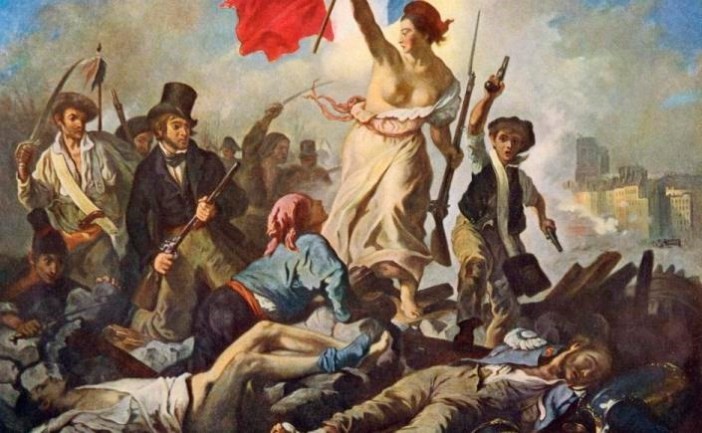
Painting “Freedom, Leading People” is famous for being the first departure from the romanticism of antiquity in politics and a reflection of harsh reality. Its plot reflects the events of 1830, which led to the expulsion of Charles X and the emergence of the parliamentary monarchy of Louis-Philippe. The aim of the Parisian uprising was to restore the republic, but the result was not fully achieved. Delacroix did not take part in another revolution in Paris. But he was a liberal and adjoined the movement of romanticists, so he did not hesitate to depict himself in the picture – a male figure in a cylinder with a gun in his hands.
The allegory of Liberty has a tricolor banner in its hands, and it is followed by a crowd of armed men, who can be seen in the clubs of smoke. High pathetics and the foreground, occupied with images of the dead, create the effect of theatricality. The realism with which the characters are painted reflects the sincere and passionate nature of the artist.
























